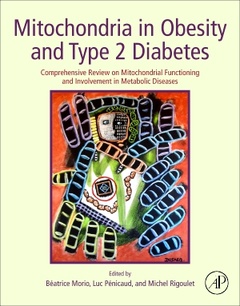Description
Mitochondria in Obesity and Type 2 Diabetes
Comprehensive Review on Mitochondrial Functioning and Involvement in Metabolic Diseases
Coordinators: Morio Beatrice, Penicaud Luc, Rigoulet Michel
Language: English
Subjects for Mitochondria in Obesity and Type 2 Diabetes:
Keywords
Adipose tissue; Alcohol; Astroglial mitochondria; Bariatric surgery; Bioenergetic adaptation; Bioenergetics; Biogenesis; Brain; Ca2+-signaling; Calorie restriction; Cardiolipin; Cardiovascular Diseases; Cell death; Ceramides; DAGs; Diabetes; Diabetes mellitus; DOHaD; Drugs; Estrogen; Ethanol; Exercise; Fatty acid oxidation; Fatty liver; Glyceroneogenesis; Glycolysis; Growth hormone; Hepatic mitochondrial function; Heteroplasmy; High carbohydrate diet; High fat diet; Homoplasmy; Hormone; HormonesMitochondria; Hyperglycemia; Hyperinsulinemia; Hyperlipidemia; Innate immunity; Insulin; Insulin resistance; Insulin sensitivity; Interventions; Islets; Ketogenic diet; Kidney function; Lipogenesis; Lipolysis; Lipotoxicity; Liver; Low protein diet; Maternal transmission; Metabolic regulation; Metabolism; Methionine restriction; Mitochondria; Mitochondrial antioxidants; Mitochondrial biogenesis; Mitochondrial carriers; Mitochondrial cofactors; Mitochondrial disease; Mitochondrial DNA; Mitochondrial DNA genetic bottleneck; Mitochondrial dynamics; Mitochondrial dysfunction; Mitochondrial NAD precursors; Mitochondrial nutrients; Mitochondrial processing peptidase; Mitochondrial reactive oxygen species; Mitophagy; Mother’s curse; Muller’s ratchet; Multigeneration; Muscle; Mutation; NADH; Neurodegenerative diseases; Nonalcoholic fatty liver disease; Nutrient sensing; Obesity; Organelle; Oxidative phosphorylation; Pancreatic ß cells; Peripheral diabetic neuropathy; Plasticity; Pollutants; Protein; Reactive lipids; Redox potential; ROS; Signaling pathway; Smoking; Steatohepatitis; Steatosis; Steroid hormone; Synaptic vesicles; Thyroid hormone; Type 2 diabetes; Type 2 diabetes; Xenobiotics
459 p. · 19x23.3 cm · Paperback
Description
/li>Contents
/li>Readership
/li>Biography
/li>Comment
/li>
Mitochondria in Obesity and Type 2 Diabetes: Comprehensive Review on Mitochondrial Functioning and Involvement in Metabolic Diseases synthesizes discoveries from laboratories around the world, enhancing our understanding of the involvement of mitochondria in the etiology of diseases, such as obesity and type 2 diabetes. Chapters illustrate and provide an overview of key concepts on topics such as the role of mitochondria in adipose tissue, cancer, cardiovascular comorbidities, skeletal muscle, the liver, kidney, and more. This book is a must-have reference for students and educational teams in biology, physiology and medicine, and researchers.
1. Mitochondrial function and structure 2. Mitochondria as signaling platforms 3. Hormonal and humoral regulation of mitochondrial function 4. Nutritional regulation of mitochondrial function 5. Mitochondrial DNA genetic and heteroplasmy 6. Role of mitochondria in the skeletal muscle metabolism in obesity and type 2 diabetes 7. Role of mitochondria in the metabolism of adipose tissues in obesity and type 2 diabetes 8. Role of mitochondria in the liver metabolism in obesity and type 2 diabetes 9. Role of mitochondria in the pancreatic beta-cells metabolism in obesity and type 2 diabetes 10. Role of mitochondria in the cardiovascular comorbidities associated to obesity and type 2 diabetes 11. Role of mitochondria in the regulation of kidney function and metabolism in type 2 diabetes 12. Role of mitochondria in the regulation of the central nervous system in obesity and type 2 diabetes 13. Impact of fetal programming on mitochondrial function and susceptibility to obesity and type 2 diabetes 14. Role of mitochondria in cancers associated to obesity and type 2 diabetes 15. Role of mitochondria in neurodegeneration in obesity and type 2 diabetes 16. Mitochondria as a target of drug toxicity and pollution: potential involvement in the development of obesity and type 2 diabetes 17. Impact of lifestyle and clinical interventions on mitochondrial function in obesity and type 2 diabetes 18. State of knowledge and recent advances in prevention and treatment of mitochondrial dysfunction in obesity and type 2 diabetes 19. Concluding chapter on "Mitochondria in obesity and type 2 diabetes"
Earlier, he held a CNRS position in the Laboratory of Nutrition at the University of Paris VI as a team leader. He is now since 2010 the Director of the Center for the Study of Taste and Feeding Behavior (CSGA) in Dijon, a Centre of over 220 members affiliated to CNRS, INRA and University of Burgundy. Luc Pénicaud is a member of several international societies such as the European Association for the Study of Diabetes (EASD), the American Diabetes Association (ADA), the European Association for the Study of Obesity (EASO), the European and International Society of Neuroscience. He is member
of different boards among which the CNRS Scientific Commission on Physiology (as President), the INRA Scientific Council, and the commission of the National Program on Diabetes. He is the author of over 215 international scientific publications, especially in the field of brain nutrient sensing and the role played by mitochondria as molecular actors.
His fields of expertise are Bioenergetics, Control and regulation of cell meta
- Synthesizes actual knowledge on mitochondrial function
- Provides an integrated vision of each tissue in the etiology of obesity and type 2 diabetes
- Identifies the interactive networks that involve alteration in mitochondrial mass and function in disease progression
- Highlights the role played by mitochondria in the prevention and treatment of obesity and type 2 diabetes
These books may interest you

Mitochondria in Liver Disease 208.65 €

Mitochondria in Liver Disease 74.82 €


